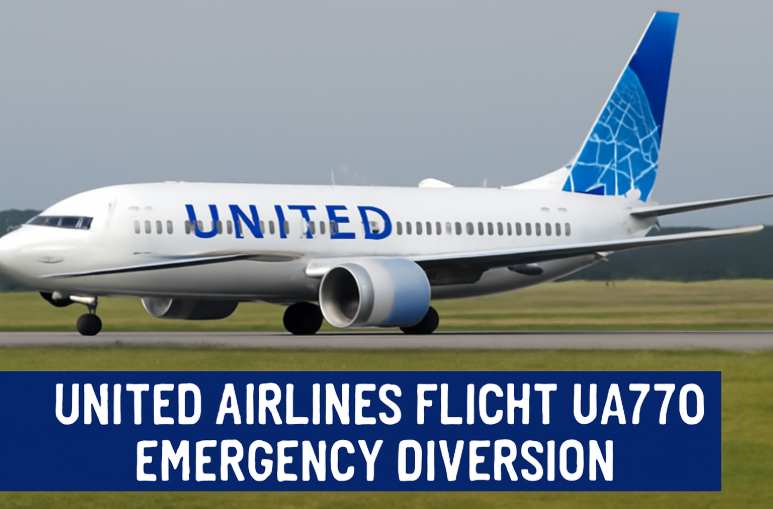On an ordinary day, passengers aboard United Airlines Flight UA770 were ready to embark on a routine journey. However, what began as a typical flight quickly escalated into an unexpected emergency, leaving passengers with a tale of uncertainty, anxiety, and ultimately, relief. United Airlines Flight UA770 was forced to make an emergency diversion that surprised everyone on board. This article dives into the details of this event, shedding light on the actions taken by the flight crew, passengers’ reactions, and how United Airlines responded to this unpredictable crisis.
What Happened During United Airlines Flight UA770?
United Airlines Flight UA770, a routine flight scheduled to travel from one city to another, was making its way through the sky when it suddenly encountered an unforeseen emergency. While passengers were settled in, enjoying the comfort of modern air travel, the situation shifted dramatically when the aircraft experienced technical difficulties that necessitated an immediate diversion.
The flight crew, acting quickly and decisively, communicated clearly with passengers about the situation, explaining the need for the emergency diversion. The pilot and crew initiated emergency protocols, ensuring that everyone on board understood the seriousness of the situation. Their calm and professional demeanor helped maintain a sense of order and composure.
Technical Issues Prompt the Diversion
It was later revealed that technical difficulties involving the aircraft’s systems prompted the emergency diversion. Although the nature of the issue was not immediately clear to passengers, the crew acted swiftly to change the plane’s flight path. As the plane veered off its original course, many passengers could feel the shift and wondered about the situation unfolding around them.
The professionalism exhibited by both the flight attendants and pilots helped ease tensions during this stressful moment. Passengers, though understandably anxious, remained hopeful, trusting that the crew was following well-established protocols for such emergencies.
Passengers’ Reactions and Experiences: From Anxiety to Relief
When an emergency diversion occurs, it naturally causes anxiety among passengers. On United Airlines Flight UA770, reactions ranged from shock to fear, with many passengers trying to make sense of what was happening. A sense of disbelief was palpable as the aircraft made its unexpected course change.
Some passengers became visibly anxious, gripping their armrests and exchanging nervous glances with fellow travelers. Others tried to distract themselves, engaging in light conversation or focusing on their music to maintain some sense of normalcy amidst the uncertainty. Still, there were those who kept calm, maintaining a sense of composure as they trusted the crew to handle the situation.
The Role of the Flight Crew in Calming the Passengers
Flight attendants played a crucial role in maintaining calm during the diversion. These trained professionals were adept at handling high-pressure situations, reassuring passengers that everything was under control. Their presence helped alleviate some of the anxiety passengers felt during the emergency.
As the plane descended toward a nearby airport, the passengers could feel their nerves shift from anxiety to cautious optimism. When the aircraft finally touched down safely, the relief was palpable. Hugs and expressions of gratitude filled the cabin as everyone realized that the worst had passed.
Sharing Stories Post-Flight
Once safely grounded, passengers began sharing their experiences. Some recounted how they had supported one another during the tense moments, while others reflected on the strange bond that had formed during this unexpected crisis. For many, it was an unforgettable experience—an adventure of sorts, albeit one that was not sought after. Still, the unity and support among strangers during a crisis were heartwarming.
United Airlines’ Response to the Emergency Diversion
United Airlines responded quickly and decisively to the situation, demonstrating a clear commitment to passenger safety and well-being. After Flight UA770 safely landed, the airline issued a statement acknowledging the incident and thanking the flight crew for their professionalism in handling the situation.
Communication with Passengers
United Airlines maintained open and transparent communication with passengers throughout the ordeal. As soon as the emergency occurred, passengers were promptly informed about the situation, including details of the emergency diversion and expected next steps. Once the plane landed safely, airline staff was on hand to assist with any further arrangements.
Post-Diversion Support for Passengers
Understanding the impact the emergency diversion had on passengers, United Airlines took immediate steps to ensure their comfort. The airline provided meal vouchers, hotel accommodations, and rebooking options for those who needed them. Customer service representatives were available to address any concerns, and the airline emphasized its commitment to keeping passengers well-informed throughout the process.
Reassurance and Support
United Airlines made sure that passengers felt supported even after the emergency. Their response to the diversion was marked by professionalism, empathy, and a clear focus on the well-being of all those affected. By acting quickly and decisively, the airline demonstrated that the safety and comfort of passengers are always top priorities.
Impact on Other Flights and Airport Operations
The emergency diversion of United Airlines Flight UA770 had far-reaching effects, both on other flights and airport operations. Air traffic controllers had to adjust schedules and reroute several flights to accommodate the diversion. This caused some delays and disruptions, affecting other travelers at the airport.
Rerouting and Delays
As a result of the emergency diversion, several nearby flights were delayed or rerouted. Passengers at connecting airports faced uncertainty, with many missing their connections. This caused frustration and confusion, and passengers scrambled to make new travel arrangements. Airport staff worked quickly to assist those affected, but the ripple effect of the diversion was felt throughout the airport system.
Heightened Alertness and Preparedness
While the emergency diversion of Flight UA770 created disruptions, it also led to heightened awareness and preparedness among airport staff. Ground crews worked to ensure that the plane was safely handled upon arrival, and emergency services were on standby. These protocols ensured that everything was in place to respond to any additional needs as soon as the aircraft touched down.
Safety Measures and Protocols for Emergency Situations
The events surrounding United Airlines Flight UA770 demonstrate the importance of safety measures and protocols in aviation. Airlines, including United, prioritize passenger safety above all else, and these procedures are essential for managing emergencies in-flight.
Pre-Flight Safety Briefings
Before every flight, passengers receive a safety briefing that covers important topics such as the use of seatbelts, life vests, and oxygen masks. These briefings are designed to ensure that passengers understand how to respond in the event of an emergency. The thoroughness of these briefings plays a crucial role in maintaining order during unexpected situations.
Flight Crew Training for Emergencies
Flight attendants are extensively trained to handle a wide range of emergency situations. They receive specialized training on how to deal with medical issues, evacuations, and other in-flight incidents. Their ability to remain calm and focused under pressure is critical for managing the safety of passengers during a crisis.
Aircraft Technology and Monitoring
Modern aircraft are equipped with advanced technology that continuously monitors key systems such as engine performance, fuel levels, and cabin pressure. This technology allows the flight crew to detect issues early and take action if necessary. The ability to respond quickly to potential issues is crucial for ensuring the safety of everyone on board.
Communication with Air Traffic Control
In emergency situations, communication between the flight crew and air traffic control is vital. Pilots maintain constant contact with air traffic controllers, who help guide the aircraft to a safe landing. Passengers are also kept informed, ensuring that they know what to expect as events unfold.
Conclusion: Lessons Learned and Future Precautions
The emergency diversion of United Airlines Flight UA770 serves as a reminder of the unpredictable nature of air travel. While such incidents are rare, they highlight the importance of preparedness and the resilience of both flight crews and passengers in times of crisis.
The Importance of Preparedness
The actions taken during the emergency diversion demonstrate that safety protocols and crew training are vital for managing unforeseen events. Lessons learned from such incidents can lead to improved safety measures and communication strategies in the future. By continually evaluating and refining emergency protocols, airlines can help ensure the safety and confidence of passengers on every flight.
Looking Ahead: Future Precautions
In the future, airlines may implement even more rigorous training programs for flight crews to enhance their ability to handle in-flight emergencies. Additionally, better passenger education regarding safety procedures will continue to play a key role in minimizing anxiety and ensuring safety during crises.
The experience of Flight UA770 underscores the need for constant vigilance and adaptation in the aviation industry. As the industry learns from each event, passengers can feel more confident that they are in capable hands.
FAQs
1. What caused the emergency diversion of United Airlines Flight UA770?
The exact cause of the emergency diversion was related to technical difficulties with the aircraft’s systems, though specifics were not immediately shared with passengers.
2. How did passengers react during the emergency diversion?
Passenger reactions ranged from anxiety to calm, with some passengers showing visible distress while others remained composed. The flight attendants played a crucial role in managing passenger concerns.
3. What steps did United Airlines take following the emergency diversion?
United Airlines responded swiftly, providing passengers with meal vouchers, hotel accommodations, and rebooking options as necessary. Customer service was available to assist with further concerns.
4. How do airlines prepare for emergency situations like the one on UA770?
Airlines prepare for emergencies through pre-flight safety briefings, crew training, advanced aircraft technology, and constant communication with air traffic control. These measures help ensure passenger safety during crises.















Leave a Reply